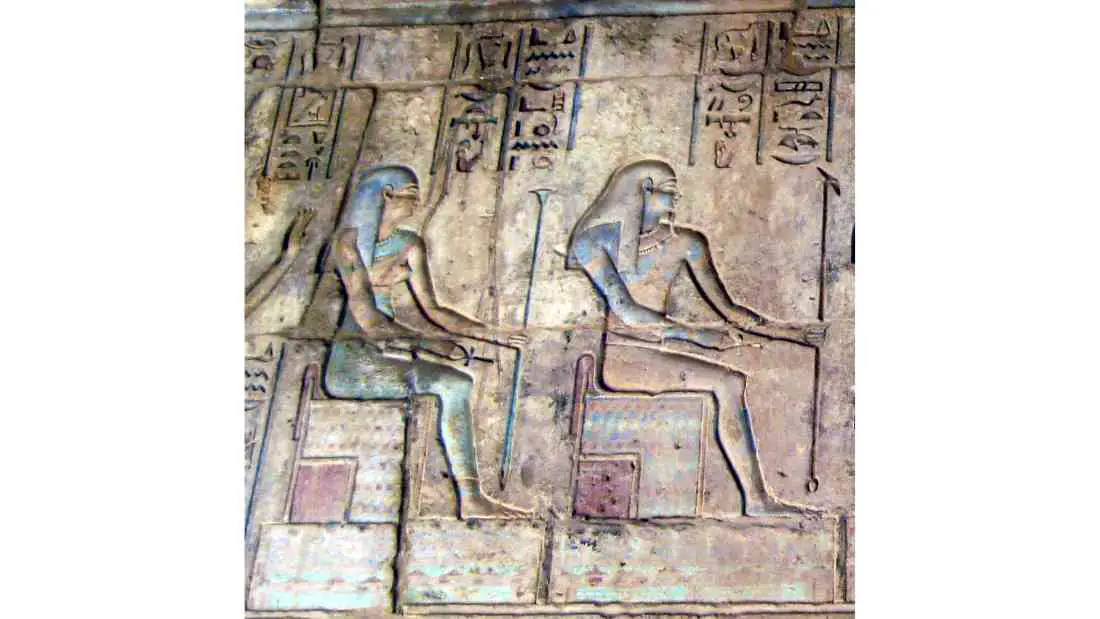Kek and Keket are part of the Ogdoad of Hermopolis, a group of eight deities who were worshipped primarily in the city of Hermopolis during the Old Kingdom period. This pantheon consisted of four male-female pairs, representing the elements of chaos: water, endlessness, darkness, and invisibility. In this Egyptian cosmology, Keke and Keket were the god and goddess of darkness.
Kek, the Egyptian god of darkness is often depicted as a frog-headed man, represents the male aspect of darkness, while Keket, his female counterpart, is often represented as a snake or a woman with a snake’s head, signifies the female aspect of this divine duality.
The Ogdoad of Hermopolis
The Ogdoad of Hermopolis, also known as the Hermopolitan Ogdoad, is a group of eight deities worshipped primarily in the ancient Egyptian city of Hermopolis.
The term ‘Ogdoad’ means ‘the eightfold’ and refers to these eight gods who were venerated as the elemental forces that existed before the creation of the world.
This sacred pantheon was composed of four pairs, each a combination of a male and female deity. Each pair embodied a specific facet of the primordial chaos: water, infinity, darkness, and invisibility.
These elements were believed by the ancient Egyptians to be the constituents of the chaotic universe before the act of creation introduced order.
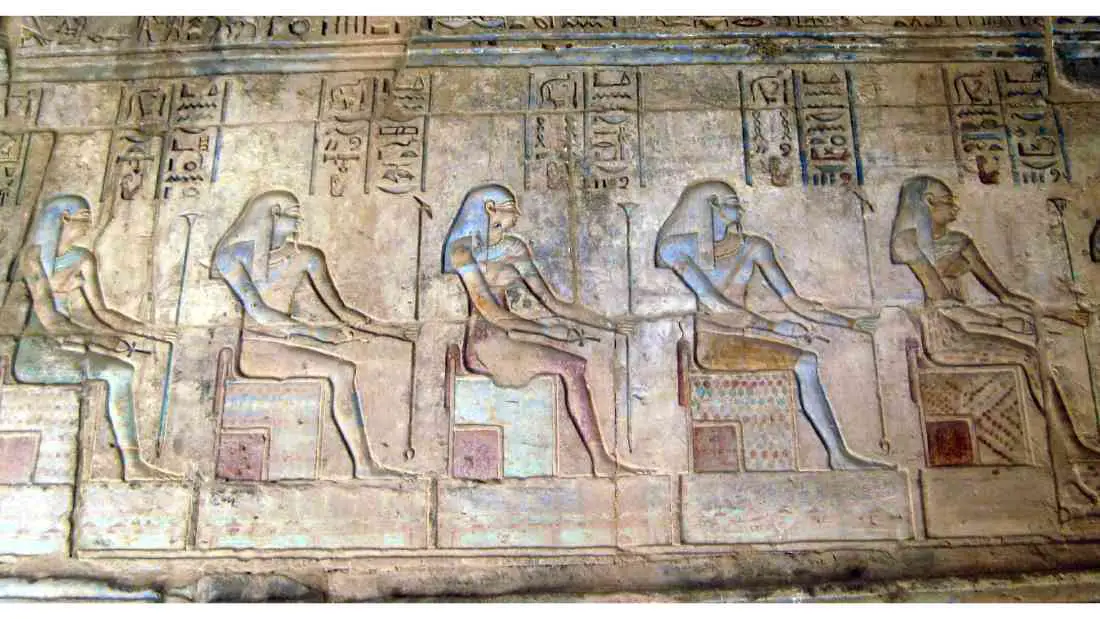
SFEC_2009_POT-0008.JPG: S F-E-Cameronderivative work: JMCC1, CC BY-SA 3.0, via Wikimedia Commons
The Deities of the Ogdoad
Nun and Naunet – The Primordial Waters
Nun and Naunet, are the divine representation of the primordial waters. These waters are believed to be the chaotic abyss from which all life originated and that surrounded the world before order was established.
Unique artistic representations of Nun often show him filled with water ripples, symbolizing his elemental identity.

In his hands, Nun is frequently depicted holding a notched palm branch. This detail reinforces his association with the primordial waters as palm branches were used in ancient Egypt to measure the annual inundation of the Nile, a key event in their agricultural calendar.
His female counterpart, Naunet, similarly represents the primordial waters but from a feminine perspective.
Together, they form a duality that reflects the ancient Egyptian understanding of the world’s beginnings – a limitless expanse of water that held the potential for life and creation.
Their role in the cosmology underscores the importance of water as a fundamental element in the ancient Egyptians’ worldview.
Heh and Hauhet – The Infinity of Space and Time
Heh, paired with his female counterpart Hauhet, are two more deities from the ancient Egyptian Ogdoad of Hermopolis. They represent the infinite and endless aspect of space and time.
Heh is usually portrayed as a male figure with a divine beard and a lappet wig, signifying his godly status.
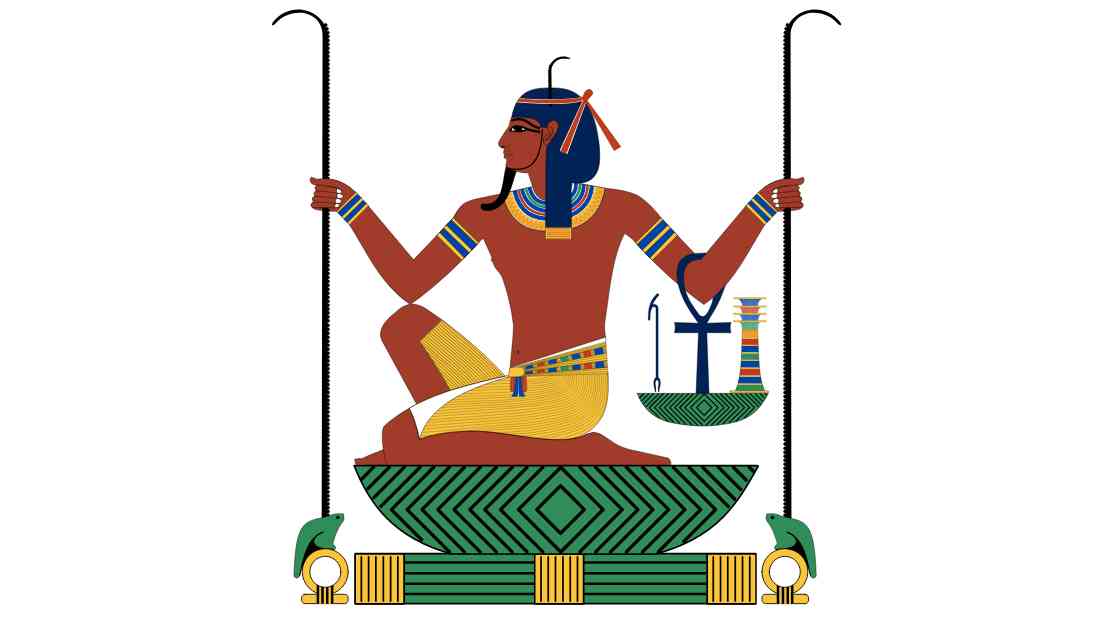
The egyptian god is normally shown kneeling, with one knee raised, sometimes positioned in a basket.
This basket is the hieroglyphic sign for “all”, further emphasizing his association with infinity and the boundlessness of the universe.
In each hand, Heh typically holds a notched palm branch, an ancient Egyptian symbol for long life and eternity. This symbolizes his control over limitless time and space, reinforcing his role as the deity of infinity.
Hauhet, on the other hand, represents the same concept but from a feminine perspective. Together, Heh and Hauhet embody the ancient Egyptians’ understanding of the infinite expanse of time and space that exists within the cosmos.
Amun and Amaunet – The Hidden Ones
Amun and Amaunet, are two integral deities within the ancient Egyptian pantheon, particularly prominent in the Ogdoad of Hermopolis. They represent the concept of the hidden or invisible aspects of life and the universe.
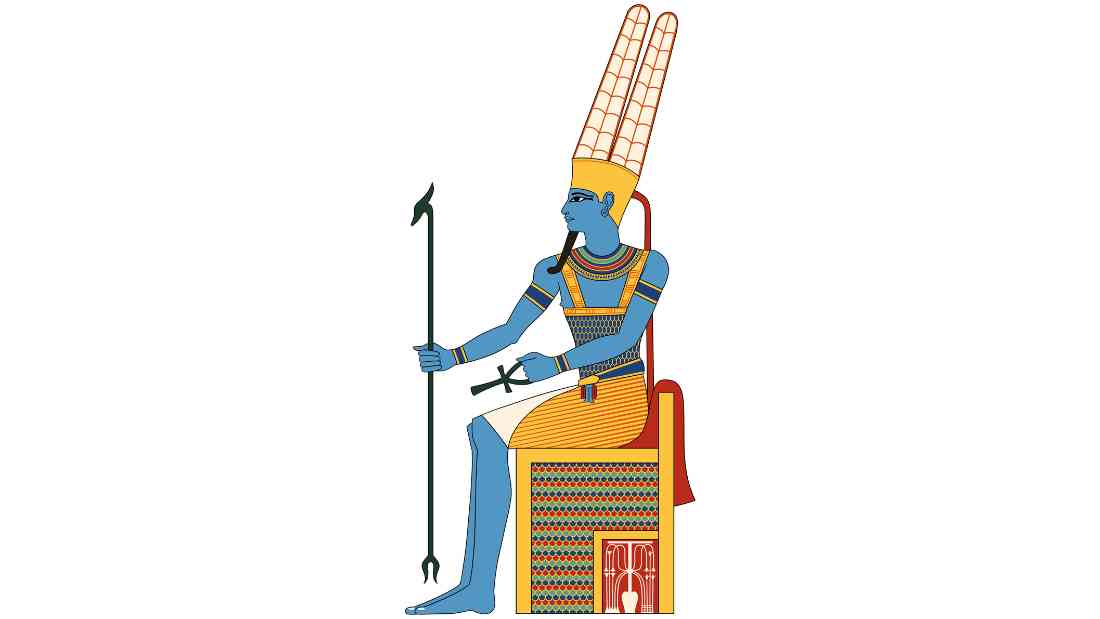
Amun, whose name means ‘the hidden one’, is often depicted as a man wearing a crown with two tall plumes.
He was originally a god of air and wind, linking him to the breath of life. Over time, his role evolved, and he became known as the king of the gods, a deity of fertility, and the force of creation itself.
His hidden aspect symbolizes the unseen forces at work in the world and the mystery of creation.
Amaunet, Amun’s female counterpart, shares his association with the hidden and unseen. Her name translates to ‘the female hidden one’.
Like Amun, she was initially linked with air and invisibility. However, in later periods, she was associated more broadly with the primeval forces of the universe. Together, they form a divine pair representing the hidden forces at work in the cosmos.

Kek and Keket – The Egyptian God and Goddess of Darkness
Kek and Keket are the god and goddess of darkness in the Hermopolis pantheon.
Kek, the Egyptian god of darkness, translated as ‘he who is in the darkness’, is typically depicted as a man with the head of a frog or as a full frog.
His association with darkness stems from the belief that he embodies the time just before dawn, when the world is still shrouded in darkness. This makes him a symbol of the unknown and the mysterious.
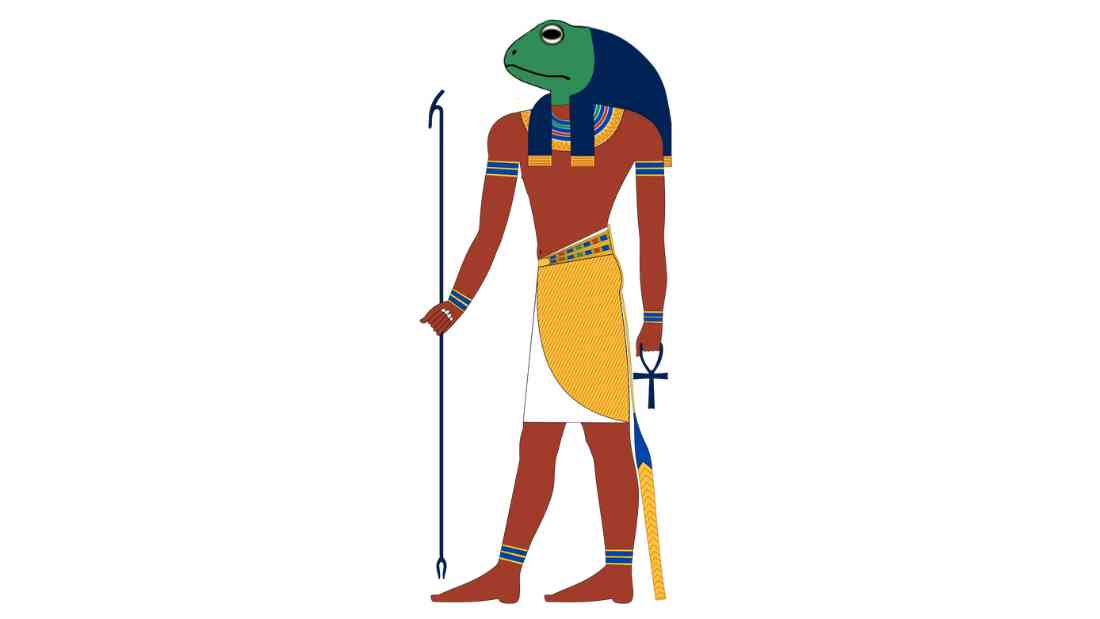
Riley Williams, CC BY-SA 4.0, via Wikimedia Commons
Keket, also known as ‘she who is in the darkness’, is Kek’s female counterpart. She is often depicted as a woman with the head of a snake or as a full snake. Like Kek, she represents the darkness before dawn, but from a feminine perspective.
The god and goddess of darkness in the Ogdoad highlight the importance of darkness within the cycle of day and night, chaos and order, and ultimately, life and death.
Kek and Keket – The Egyptian God and Goddess of Darkness in Creation Myths
In the complex tapestry of ancient Egyptian mythology, Kek and Keket, the god and goddess of darkness, hold a pivotal role.
The universe’s birth, according to this belief system, was a result of the dynamic interaction among the eight gods embodying primeval forces that existed before the world was formed. Kek and Keket, the god and goddess of darkness, had a crucial role to play in the creation of the world.
The process of creation began with the chaotic waters of Nu and Naunet giving rise to a mound. This mound was the stage upon which the sun god Ra made his first appearance. In some versions of the myth, it was Atum or Thoth instead of Ra who emerged, marking the significant act of creation.
In this grand drama of genesis, Kek and Keket, the god and goddess of darkness, heralded the first dawn. They were the darkness from which the sun rose and into which it set, the eternal obscurity that existed beyond the edge of the world.
Their role as the deities of darkness made them the harbingers of light, a paradox that underscores the duality inherent in their nature.
Just as the day follows night, the creation of the universe couldn’t occur without the darkness that preceded it. Kek, the Egyptian god of darkness, and Keket, the goddess of darkness, were thus instrumental in the transition from the primeval chaos to the ordered world.
Simultaneously, Heh and Hauhet, representing infinity, provided the boundless space necessary for creation to unfold. The interplay between these forces — the darkness of Kek and Keket, the god and goddess of darkness, and the infinite expanse of Heh and Hauhet — set the stage for the emergence of the cosmos.
Thus Kek and Keket, the Egyptian god and goddess of darkness, personify the essential darkness that gives way to light, underscoring the balance and cyclical nature of the universe.
Final Thoughts on Kek and Keket, the Egyptian God and Goddess of Darkness
In the ancient Egyptian understanding of cosmology, the world was created out of chaos.
Kek and Keket, as the bearers of darkness, were crucial to this process. They represented the state of the universe before the act of creation brought order, making them integral to the Egyptians’ perception of the cosmos.
Their existence allowed for the distinction between day and night, order and chaos, light and darkness.
Thus, although they are not as famous as deities like Ra or Osiris, Kek and Keket play a vital role in ancient Egyptian mythology. As the god and goddess of darkness, they highligh the nuanced perception of darkness in ancient Egyptian culture – not as a sinister force, but as a necessary and powerful part of existence.

Frequently Asked Questions About Kek, the Egyptian God of Darkness
Kek is an ancient Egyptian god associated with the primordial darkness that existed before creation. He is part of the Ogdoad, a group of eight gods who represent the chaos that existed before the universe was formed.
Kek symbolizes the darkness just before dawn, embodying the time of day when it is neither day nor night. This makes him a symbol of the unknown and the mysterious.
Kek is often depicted as a man with the head of a frog or as a full frog. These representations connect him to the primeval waters from which the world was believed to have emerged.
In the Hermopolitan cosmogony, Kek played a crucial role in the transition from chaos to order. As the god of darkness, he heralded the first dawn, marking the emergence of light and the beginning of creation.
Keket is the female counterpart of Kek. Like Kek, she represents the darkness before dawn, but from a feminine perspective. Together, they embody the balance of male and female forces in the cosmos.
For Further Reading
Large Stockpile of Embalming Equipment discovered in Abusir
Mummification: Why did the Ancient Egyptians embalm their dead?
Saba Mahmood – a strong voice in the anthropology of religion and post-colonialism
Unravelling the Mysteries of Ancient Egyptian Symbols of Death – Anthropology Review
The Wrath of Montu – The Mythology of the Egyptian War God
Exploring the Egyptian Middle Kingdom – A Historical Overview
Examining the Rich Hues of Ancient Egyptian Paint
Ancient Egyptian Temples: Spiritual Centers of the Nile Civilization
The Symbolism and Significance of Ancient Egyptian Jewelry
The Pantheon of Ancient Egyptian Gods – A Comprehensive Guide
Temple of Seti I: An Architectural Marvel in the Ancient City of Abydos

